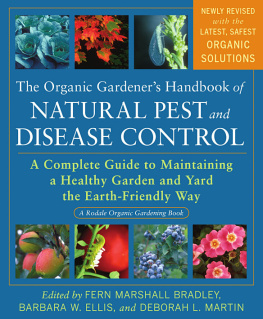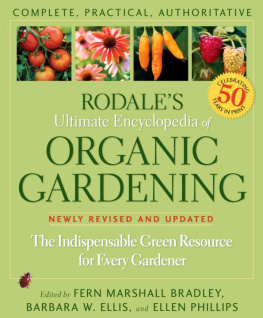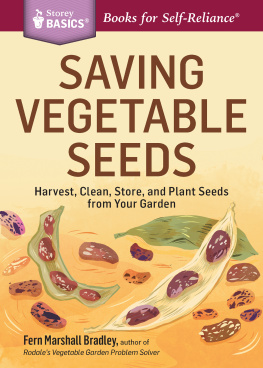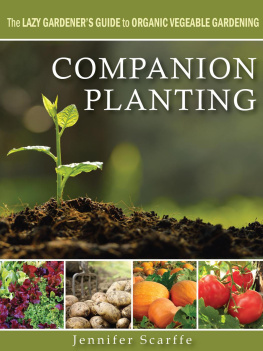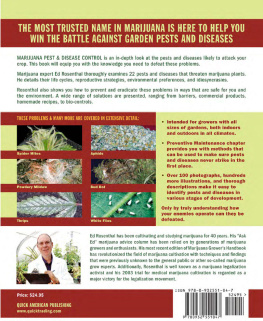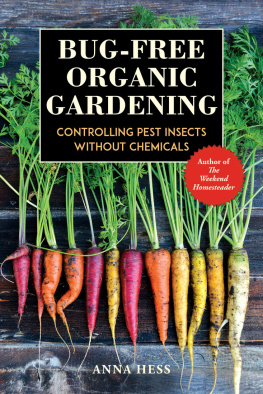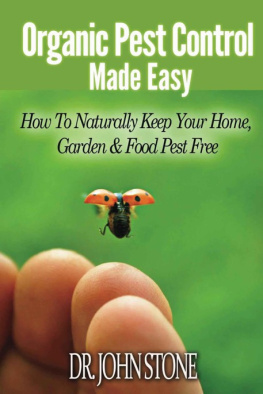Whether its spots on the tomatoes, hostas that mysteriously wilt and die, or worm-eaten apples, damage from pests and disease organisms is never welcome. How to manage these problems is a top concern of gardeners everywhere. This newly revised edition of a classic reference on organic solutions to pest and disease problems has been fully updated, and its quick-reference format will help you find the most up-to-date information for a wide range of common insect and disease problems.
HOW TO FIND IT
One look at the contents will illustrate that The Organic Gardeners Handbook of Natural Pest and Disease Control is really four books in one. Once youve paged through it to familiarize yourself with the format, flipping to the section you need will become second nature. And for quick and easy access to information, dont forget the index. Heres a rundown of what is included.
Part 1, Your Healthy Garden, is an overview of the basic practices of organic gardening to help you prevent problems before they ever get started. By learning how to build organically active soil, choose plants that are well adapted to conditions, and effectively tend your crops and ornamental plantings throughout the season, youll create a balanced system in which problems are regulated naturally and there are few outbreaks of pests and diseases. This section is especially important for new gardeners and gardeners who have just switched to organic methods.
Part 2, Symptoms and Solutions, contains a plant encyclopedia with symptoms and solutions for the major problems suffered by popular plantsincluding fruits, vegetables, annuals, bulbs, perennials, and trees and shrubs. It also contains preventive information and general entries on the major plant groups.
Part 3, Identifying Pests and Diseases, features a photographic guide to garden pests and their natural enemies, and symptoms of diseases and disorders. It includes descriptions, life cycle information, and summaries of control options. With more than 225 color photographs, this section is an excellent starting point for diagnosing problems and deciding what to do about them.
Part 4, Organic Pest and Disease Management, is a thorough guide to nonchemical options for stopping insects in their tracks or curbing diseases before they overtake your yard. It begins with low-impact techniques that prevent problems by keeping pests and diseases from reaching your plants. There is a thorough discussion of biological controls, including naturally occurring biocontrols and commercial biocontrol products. To conclude, theres a rundown of homemade and commercial sprays and dusts that home gardeners can use to repel or kill pests and to prevent or lessen disease problems. Some of these products are offered as a last resort onlyfor the exceptional cases when the natural balance has been disturbed and pest problems threaten to ruin the harvest or kill your plants.
REMEMBERING THE BIG PICTURE
As you use this book, its important that you not lose sight of the big picture of gardening organically. One of the principles at the heart of organic gardening is eliminating the need to use sprays and dusts at all. This may seem like a difficulteven unrealisticgoal to strive for, but organic gardeners everywhere will attest to the fact that it makes gardening more enjoyableand saferthan ever. Youll be much more successful if you emphasize practices that promote garden health and management strategies that rely on nontoxic intervention methods.
So where do you start? Logically enough, at the beginning. Part 1 will set you on the path to creating the kind of garden environment that helps plants stay healthy naturally. Youll also find that the individual plant entries in Part 2 contain lots of helpful growing tips. Read and follow these to avoid many common garden problems.
While the individual plant, pest, and disease entries in Parts 2 and 3 do list some preventive measures, they are primarily designed to help you decide what to do once youve encountered specific problems in your garden. But keep in mind that preventive measures are the keys to successful organic gardening. To get the most out of this bookand to develop an effective management system for your gardenmake sure youve implemented as many of the preventive methods discussed in Part 1 as possible.
When you do encounter a problem, then Part 4 will be your resource for making a plan to solve the problem.
Youll find that this revised edition is an invaluable reference for finding solutions to garden problems, with fully updated information throughout. When you follow a recommendation for controlling a specific insect or disease, always use the least-invasive method available.
Since some botanical poisons and copper and sulfur sprays are allowed for use (with restrictions) according to the National Organic Program regulations, we have included them in our recommendations throughout this book. (See Organic and Natural on page 3 for more information on the National Organic Program.) Thus, in total, the book includes hundreds of listings of pyrethrins, neem, sulfur, and copper as management options for specific pests or diseases. This does not mean we endorse widespread use of these substances. In your individual garden, you should opt to use one of these sprays or dusts only in exceptional cases.
If you do decide to use a botanical poison or a sulfur or copper product, remember that they can be dangerous to people as well as to plant pests and diseases. Never use them casually or carelessly. Whenever you use commercial products, always read and follow label directions.
In the big picture, we hope you gain a greater appreciation for just how well plants can keep themselves healthy, given the opportunity. Even in the middle of summer, when pest problems are more severe, bear in mind that the crisis will pass and your plants will get another chance with each new season. Plants have been making use of these second chancesdevising their own self-defense trickssince time began. Learning and using natural pest and disease management strategies gets you involved in these adventures, which are part of the fun and fascination of gardening.
COVER PHOTOGRAPHS
Photodisc (leaves)
Rodale Images (cabbage, apples, blueberries)
Robert Cardillo/Rodale Images (hornworm, flowers)
Bill Beatty/Visuals Unlimited, Inc. (lacewing)
INTERIOR PHOTOGRAPHS
Blickwinkel/Alamy: page 283 (pear slug)
Nigel Cattlin/Alamy: pages 275 (rust mite damage), 280 (vine weevil damage), 282, 283 (cottony cushion scale), 298 (predatory mite), 316, 318 (nitrogen deficiency), 321 (verticillium wilt), 323 (curly top virus), 330 (powdery mildew), 333 (cane blight), 336 (fire blight), 340 (club root), 344 (damping-off )
Custom Life Science Images/Alamy: page 301 (spider)
Florida Images/Alamy: page 276 (mole cricket)
Graphic Science/Alamy: page 289 (vinegar fly)
B. Mete Uz/Alamy: page 269 ( Japanese beetle)
Wildlife GMBH/Alamy: pages 296 (mealybug destroyer), 297 (mealybug destroyer larva)
Jack Clark/Animals Animals: page 277 (fruit moth larva)
Breck P. Kent/Animals Animals: pages 267 (grasshopper), 299 (parasitized hornworm)
PremaPhotos/Animals Animals: page 303
James Robinson/Animals Animals: page 299 (cicada killer wasp)
Richard Shiell/Animals Animals: page 287 (flower thrips)
Donald Specker/Animals Animals: pages 265 (flea beetle damage), 271 (leafhopper), 286 (squash vine borer)
Wild & Natural/Animals Animals: pages 273 (bean beetle damage), 293 (assassin bug)
OSF/Konrad Wothe/Animals Animals: page 260 (potato beetle damage)
Dr. Tristan Bantock: page 294
Dr. Jeffrey K. Barnes: page 266 (fleahopper)

